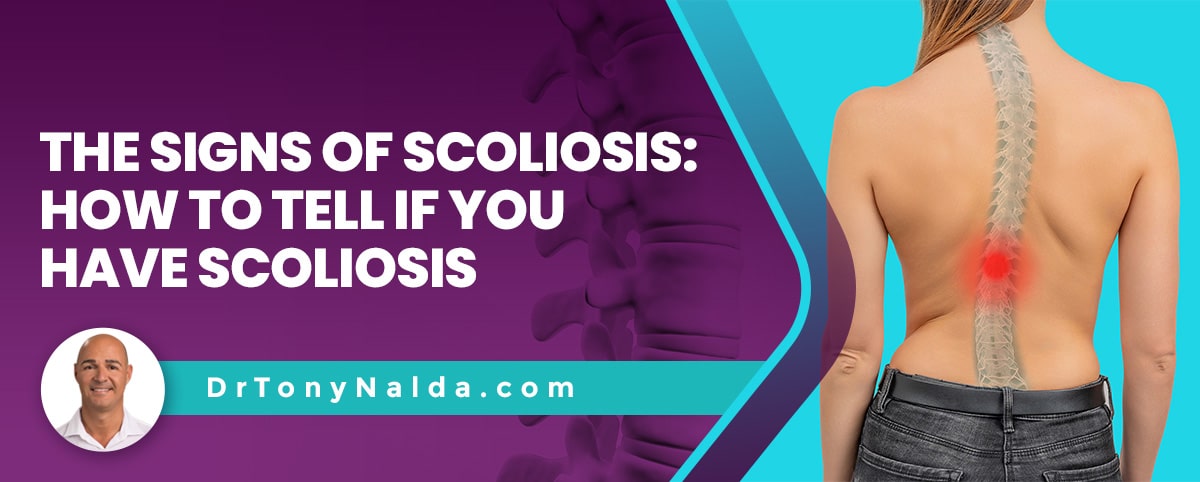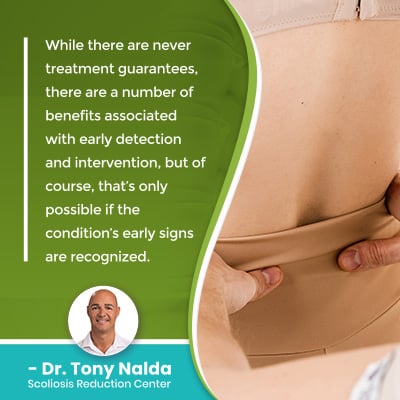The Signs of Scoliosis: How To Tell If You Have Scoliosis

Although scoliosis is a spinal condition, it can affect multiple areas of the body, and not just the spine. Scoliosis introduces a lot of uneven forces to the body that can disrupt its overall symmetry, and once the condition becomes compressive in adulthood, it can cause varying levels of pain. The only way to truly know if you have scoliosis is to receive a diagnosis delivered by a medical professional.
There are different ways to tell if you have scoliosis, and most involve recognizing the early postural changes the condition causes. In children, the condition’s earliest signs are often uneven shoulders and hips, and in adults, pain is the condition’s main symptom.
Knowing the signs of scoliosis can lead to early detection, and when responded to with proactive treatment, there are fewer limits to what can be achieved.
Table of Contents
The Benefits of Early Detection
 While there are never treatment guarantees, there are a number of benefits associated with early detection and intervention, but of course, that’s only possible if the condition’s early signs are recognized.
While there are never treatment guarantees, there are a number of benefits associated with early detection and intervention, but of course, that’s only possible if the condition’s early signs are recognized.
Scoliosis is a progressive condition, meaning its nature is to get worse over time, and as it involves the development of an unnatural sideways spinal curve with rotation, it’s a complex 3-dimensional structural spinal condition.
The condition’s severity levels are the same as its progressive line, and the more severe a condition, the more likely it is to have noticeable signs and symptoms.
Scoliosis ranges from mild to moderate and severe to very severe, and severity is classified based on a patient’s Cobb angle.
Cobb angle is known as the gold standard in the assessment of scoliosis and is determined during X-ray by drawing lines from the tops and bottoms of the curve’s most-tilted vertebrae.
The resulting angle is expressed in degrees, and the higher a patient’s Cobb angle, the more noticeable their condition is likely to be, and the further out of alignment the spine is:
- Mild scoliosis: Cobb angle measurement of between 10 and 25 degrees
- Moderate scoliosis: Cobb angle measurement of between 25 and 40 degrees
- Severe scoliosis: Cobb angle measurement of 40+ degrees
- Very-severe scoliosis: Cobb angle measurement of 80+ degrees
As a progressive condition, where a scoliosis is at the time of diagnosis is not indicative of where it will stay, especially not without the help of proactive treatment that works towards counteracting its progressive nature.
As scoliosis progresses, the size of the unnatural spinal curve is increasing, as are the condition’s uneven forces, and their effects.
As a scoliotic curve gets larger, the spine gets more rigid, making it less responsive to treatment, and increasing spinal rigidity can also make it difficult for patients to perform certain therapeutic exercises as part of treatment.
In addition, the longer a condition is left to progress, the more time the body has to adjust to the unnatural spinal curve’s presence, so it’s far better to start treatment early in the condition’s progressive line than it is to watch and wait.
It’s far simpler to proactively work towards preventing progression and increasing condition-effects, than it is to work towards reversing those effects once they’ve developed: the benefits of early detection.
So what are the signs of scoliosis, and is the most overt sign the same in child and adult scoliosis?
Signs of Scoliosis in Children
Scoliosis affects all ages from babies born with congenital scoliosis to infantile scoliosis diagnosed between the ages of 6 months and 3 years, early-onset juvenile scoliosis diagnosed between the ages of 3 and 10, and the most prevalent form of scoliosis overall: adolescent idiopathic scoliosis (AIS), diagnosed between the ages of 10 and 18.
The idiopathic designation means not clearly associated with a single-known cause, and idiopathic scoliosis accounts for approximately 80 percent of known diagnosed cases.
While we don’t know what triggers the onset of the majority of scoliosis cases, we do understand what triggers its progression: growth and development.
So children who have not yet reached skeletal maturity are at risk for rapid progression, especially adolescents who are experiencing the rapid and unpredictable growth spurts associated with puberty.
In children, the condition’s earliest signs are often uneven shoulders and hips, and this is due to how the condition’s uneven forces disrupts the body’s overall symmetry.
In addition to uneven shoulders and hips, postural changes can also include:
- An uneven eyeline
- Uneven shoulder blades
- The development of a rib arch
- An uneven waistline
- Arms and legs that appear to hang at different lengths
Additional changes to watch for are changes to gait, balance, coordination, and clothing suddenly seeming ill-fitting.
In mild cases, scoliosis isn’t known to cause noticeable functional deficits, its postural changes can be subtle, and as scoliosis doesn’t become compressive until adulthood, children don’t commonly experience a lot of condition-related pain.
So the most recognizable signs of scoliosis in children are postural changes, and it’s often uneven shoulders and hips that are the earliest condition indicators to appear.
Now, let’s move onto the signs of scoliosis in adults.
Signs of Scoliosis in Adults
While scoliosis is most commonly diagnosed in children, it does also affect adults, and the two most common types to affect adults are idiopathic scoliosis and degenerative scoliosis.
As mentioned, 80 percent of scoliosis cases are idiopathic, and the remaining 20 percent are associated with known causes: neuromuscular scoliosis, degenerative scoliosis, and congenital scoliosis.
Idiopathic scoliosis is the most common type to affect adults, and these cases are extensions of AIS patients who weren’t diagnosed or treated during adolescence so progressed with time and maturity into adulthood; this is a common scenario.
Once skeletal maturity has been reached, there is no longer the constant lengthening motion of a growing spine to counteract the compressive force of the scoliotic curve; it’s compression of the spine and its surrounding muscles and nerves that causes the majority of condition-related pain.
Adult scoliosis pain can include localized back pain, general back pain, and most commonly, nerve pain that radiates into the extremities.
Degenerative scoliosis is caused by natural age-related spinal degeneration that makes the spine unstable.
 When scoliosis becomes compressive, it tends to become painful, which is why pain is the number one sign of scoliosis in adults, and it’s the main symptom that brings them in to see me for a diagnosis and treatment.
When scoliosis becomes compressive, it tends to become painful, which is why pain is the number one sign of scoliosis in adults, and it’s the main symptom that brings them in to see me for a diagnosis and treatment.
While pain is the main sign of scoliosis in adults, they do also experience postural changes such as a prominent lean to one side that’s most noticeable when in a forward-bend position.
So assuming scoliosis has been diagnosed early, after recognizing its early signs, what’s the next step?
Scoliosis Treatment Options
If early detection has been achieved, now is the time to benefit from it.
Early detection is only beneficial if a diagnosis is responded to with a proactive treatment plan started immediately; remember, scoliosis only gets more difficult to treat over time.
Following a diagnosis, the most important decision to be made is how to treat the condition moving forward, and there are two main treatment approaches to divide between: traditional and conservative treatment.
Traditional scoliosis treatment is more reactive than proactive and offers a surgical response, and spinal fusion surgery is a lengthy, costly, and invasive procedure that can cost the spine in terms of its overall strength, health, and function.
Modern conservative treatment is what I offer patients of the Scoliosis Reduction Center, and this response is proactive and involves starting treatment as close to the time of diagnosis as possible, and this helps achieve one of my treatment goals: helping patients avoid the need for invasive surgical treatment in the future.
I also want to work towards achieving corrective results in the form of a curvature reduction, increased core strength, and rehabilitation.
Through condition-specific chiropractic care, I can work towards reducing the size of the unnatural spinal curve on a structural level; through condition-specific physical therapy, I can increase the strength of the spine’s surrounding muscles so it can provide it with optimal support.
Through corrective bracing, the spine is pushed into a corrective position, and a series of custom-prescribed scoliosis-specific exercises (SSEs) can help patients establish a home-rehabilitation program to further stabilize and heal the spine.
Conclusion
When it comes to recognizing the early signs of scoliosis, we’re talking about postural changes in children and pain in adults.
While I can never give treatment guarantees, I do point out to my patients diagnosed with mild scoliosis that the chances of treatment success are higher because it was diagnosed, and now can be treated, while mild.
The more a condition progresses, the more complex it is to treat, and as a progressive condition, scoliosis is virtually guaranteed to get worse at some point, so any type of watching and waiting is wasting valuable treatment time.
If the condition’s early signs have been recognized, a medical professional can perform a screening exam and order an X-ray to officially reach a diagnosis of scoliosis, which is the only way to truly know you have scoliosis.
Regardless of the patient's age or condition severity, however, the best time to start scoliosis treatment is always now, so if you or someone you care about is showing condition indicators, don’t hesitate to reach out for guidance and support.
Dr. Tony Nalda
DOCTOR OF CHIROPRACTIC
After receiving an undergraduate degree in psychology and his Doctorate of Chiropractic from Life University, Dr. Nalda settled in Celebration, Florida and proceeded to build one of Central Florida’s most successful chiropractic clinics.
His experience with patients suffering from scoliosis, and the confusion and frustration they faced, led him to seek a specialty in scoliosis care. In 2006 he completed his Intensive Care Certification from CLEAR Institute, a leading scoliosis educational and certification center.
About Dr. Tony Nalda
 Ready to explore scoliosis treatment? Contact Us Now
Ready to explore scoliosis treatment? Contact Us Now





